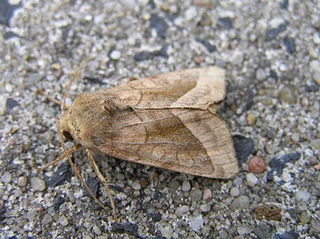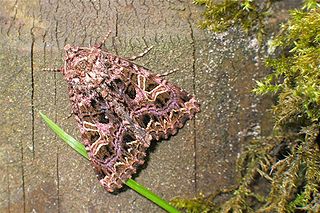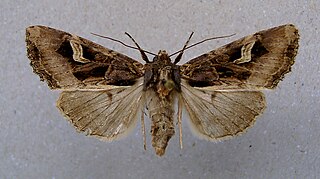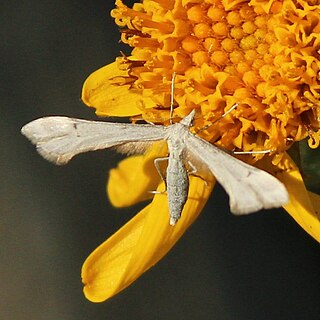Related Research Articles

Apamea crenata, known as the clouded-bordered brindle, is a moth in the family Noctuidae. It is distributed throughout the Palearctic realm. In the North it crosses the Arctic Circle, in the Mediterranean it is found only in cool locations and mountains avoiding very hot areas. In the Alps, it rises to an altitude of about 2000 metres.

The silver Y is a migratory moth of the family Noctuidae which is named for the silvery Y-shaped mark on each of its forewings.

Idaea dimidiata, the single-dotted wave, is a moth of the family Geometridae. It is a Holarctic species.

Hydraecia micacea, the rosy rustic, is a moth of the family Noctuoidea. It is found across the Palearctic realm from Ireland to Siberia. It reaches Japan and is introduced to eastern USA, Quebec and Ottawa.

Colocasia coryli is a moth of the family Noctuidae. It is found in Europe and Asia. In the north of its range, the distribution area includes northern Scandinavia, while in the south the moth is limited to montane areas of western and northern Spain, Sicily, Greece and Asia minor. To the east, the range extends across the Palearctic to Lake Baikal. In the Alps it is found at elevations up to 1600 m.

Sideridis rivularis, the campion, is a species of moth of the family Noctuidae. It is found in from the northern part of the Iberian Peninsula, through the whole of Europe. To the east, it is found in Central Asia and Siberia, up to Manchuria. To the south, it is found in the Mediterranean Sea region and parts of Asia Minor. In the Alps, it is found at up to 1,600 metres above sea level.

Pyrausta despicata, the straw-barred pearl, is a species of moth of the family Crambidae. It was described by Giovanni Antonio Scopoli in his 1763 Entomologia Carniolica.

Scoparia subfusca is a species of moth of the family Crambidae. It is found in Europe.

Polia bombycina is a moth of the family Noctuidae. It is found in the Palearctic realm from Ireland to Japan including the Russian Far East and Siberia.
Ophiusa disjungens, the guava moth, is a moth of the family Erebidae. The species was first described by Francis Walker in 1858. It is found in south-east Asia and the south Pacific, including Thailand, Japan, Tonga and New South Wales and Queensland. The adult is a fruit piercer.

The flame brocade is a moth of the family Noctuidae. The nominate subspecies T. f. flammea is found in Europe, mostly in the Mediterranean area up to Normandy. It is also found on the Channel Islands and it has spread to Southern England and Ireland. It is found in the Maghreb as the subspecies T. f. vividior. This also occurs in parts of Spain. The species lives primarily in dry areas, on warm slopes, grassy scrubland and in karstic oak.

Epipsilia grisescens is a moth of the family Noctuidae. It is found in Fennoscandia, Denmark as well as the Pyrenees, Alps, Apennines, Balkans and Carpathians. In the Alps it is found up to 2,000 meters.

Ctenoplusia albostriata, the eastern streaked plusia, is a moth of the family Noctuidae. It is found in India, Sri Lanka, eastern Asia and the Pacific, including Borneo, Hong Kong, Vietnam, Japan, most of Australia and New Zealand.

Gillmeria albertae is a moth of the family Pterophoridae first described by William Barnes and Arthur Ward Lindsey in 1921. It is known from the mountains of Alberta near Banff.

The Beautiful Gothic(Leucochlaena oditis) is a Palearctic moth of the family Noctuidae, sub-family Cuculliinae. It is found in southern Europe and north Africa, with occasional finds on the southern coast of England.
Garrha gypsopyga is a moth in the family Oecophoridae. It was described by Turner in 1946. It is found in Australia, where it has been recorded from New South Wales.
Epermenia macescens is a moth in the family Epermeniidae. It was described by Edward Meyrick in 1917. It is found in India.
Compsoctena media is a moth in the Eriocottidae family. It was described by Walsingham in 1897. It is found in the Central African Republic.
Tanycnema is a monotypic moth genus of the family Tineodidae or false plume moths. It was described by Alfred Jefferis Turner in 1922. Turner described the genus in Proceedings of the Royal Society of Victoria, writing:
Gen. Tanycnema, nov.
Frons with a strong anterior tuft of hairs. Tongue present. Palpi rather long, porrect. Maxillary palpi obsolete. Antennae short. Legs long, slender; outer tibial spurs about 3/4 length of inner spurs. Forewings narrow, elongate; 2 from well before angle, 3 from angle, 4 and 5 somewhat approximate at origin, 6 from upper angle, 7, 8, 9, 10 stalked, 7 arising slightly before 10, 11 free. Hindwings twice as broad as forewings; 2 from 3/4, 3 from angle, 4 and 5 somewhat approximate at origin, 6 well separated at origin from 5, still more widely from 7, 7 from upper angle, closely approximated to 12 for some distance, but not anastomosing.
A peculiar, isolated, and primitive genus. The wide separation of 6 from 7 of the hindwings, and the absence of any anastomosis of 7 with 12 are primitive characters; on the other hand the relative approximation of 5 to 4 in the hindwings, and the stalking of 7 and 10 of the forewings are specialised characters, the former being unique in this family, to which the genus must, I think, be referred, though the absence of maxillary palpi, suggests some relationship to the Pterophoridae, but this may be more apparent than real.
References
- ↑ Beccaloni, G.; Scoble, M.; Kitching, I.; Simonsen, T.; Robinson, G.; Pitkin, B.; Hine, A.; Lyal, C., eds. (2003). "Oxypteryx". The Global Lepidoptera Names Index . Natural History Museum . Retrieved May 27, 2018.
- ↑ Oxypteryx at funet
- ↑ Afro Moths
- ↑ Verh. zool-bot. Ges. Wien 61: 151
 This article incorporates text from this source, which is in the public domain .
This article incorporates text from this source, which is in the public domain .